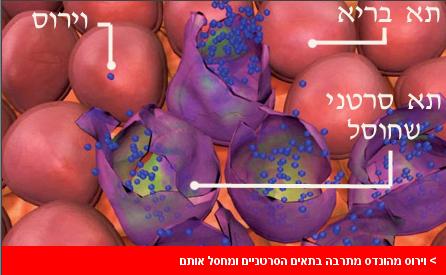Genetic engineering turns deadly viruses into a smart cure for cancer
Popular Sciences

Direct link to this page: https://www.hayadan.org.il/popscivirus1.html
In February 2005, researchers from the University of California in Los Angeles announced the beginning of a battle of biotechnological giants, when they turned one of the most threatening viruses known to mankind - HIV - into an effective fighter against another terrible disease: cancer. In experiments conducted on mice suffering from melanoma, engineered HIV viruses attacked cancer cells without the mice becoming infected with AIDS. At the same time, Mayo Clinic researchers in Minnesota announced similar findings - after programming measles viruses to locate cancerous tumors and destroy them without harming healthy tissue.
The closeness of time between the announcements is not accidental. Many studies have recently been conducted in the field of virotherapy, while trying to take advantage of the tendency of viruses to attack cancer cells in order to achieve victory in a battle in which until now medicine has mostly suffered losses. After the first studies showed that many of the viruses are harmless to humans, several universities and biotech companies began to conduct clinical trials in virotherapy.
Although the idea sounds bold and innovative, the first attempts to inoculate viruses in cancerous tumors were conducted long before genetic research began. In the fifties of the last century, scientists proved that adenovirus - a certain type of common virus that causes colds - is quite effective as a treatment for throat cancer. However, the study was abandoned after chemotherapy gained momentum. Virotherapy was only revived after a study was published in 1991 that showed that viruses could be genetically engineered to attack tumors without causing disease.
The secret lies in bringing the right virus to the right place - that is, introducing it into the malignant tumor, where it will multiply, eliminate the existing cancer cells and attack new cancer cells without activating the body's immune system. The virus is usually injected directly into the tumor, but in certain areas of the body, such as the brain, it is difficult to do so. The desired goal is to inject the virus by intravenous infusion, but with this method, the body's defense mechanisms may wake up and the virus will be rejected even before it reaches the tumor.
The engineered measles virus used in the experiment was indeed one of the first to be introduced through the mouse's bloodstream. In order to trick the body's defense mechanisms, the scientists prepared a "specialized" measles virus, which underwent genetic changes and reaches the tumor directly. The same is the case with the HIV virus: the researchers of the University of California in Los Angeles made changes in the virus that make it seek out the melanoma cells and destroy them. The scientists equip the virus with certain hooks that give it a grip on different molecules.
Although these studies look promising, many more years may pass before virotherapy will gain practical application in medicine. Human trials are not expected to be conducted for the next three years, and even more conservative drugs need many years of trials before they are approved by the FDA. Still, the experts have high hopes in this direction. In the coming years we will know if the threatening viruses can also become friends.
The bacteria and viruses know
Cancer research expert
Interested in a subscription - NIS 49 sale for three months
https://www.hayadan.org.il/BuildaGate4/general2/data_card.php?Cat=~~~230057815~~~244&SiteName=hayadan
